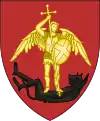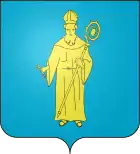Symbols of Brussels
There are currently two symbols of the Brussels. Both the flag and the emblem of the Brussels-Capital Region depict the Iris pseudacorus (yellow iris), a flower native to the Brussels area. Additionally, every municipality of the region has its own flag and coat of arms.
Flag

The flag of the Brussels-Capital Region depicts the Iris pseudacorus (yellow iris), which is native to the Brussels area, against a blue backdrop.
The valley of the river Senne has been housing Brussels for more than 1,000 years. With time, the lower town has progressively spread through the marshy bottoms. In the Dukes of Brabant's times, the marshy plains covered with golden irises encircled the town walls. According to a legend, this simple plant gave a great strategic victory to the Duke's soldiers. Those knew that iris can grow immersed only in a few centimeters of water. They broke into a gallop through the flooded plains but carefully let their horses stamping iris hills. Their opponents, less knowledgeable in botanics and encouraged by the apparently careless gallop of the Duke's soldiers, got definitively bogged into the marshes.
Iris pseudacorus is the scientific name of the golden iris, the symbol of the region of Brussels-Capital, which is widely used (tramways, subway, taxis etc...) but ill-known.
The choice of this marsh iris as the symbol of Brussels did not occur for the creation of the region of Brussels-Capital (18 June 1989), as often believed. In 1924, R. Cornette wrote that "this flower was chosen because it grows in the marshes, recalling that the capital was funded on the marshy banks of the Senne river and its tributaries" (Maalbeek, Roodkloosterbeek, Geleytsbeek, Kerkebeek, Leybeek, Woluwe...). Nowadays, in spite of the ultra-rapid urbanisation, the iris can still be found in its naturel habit in the vale of Vuylbeek, in the forest of Soignes.
Emblem

On 5 March 1991, the Regional Council of Brussels-Capital chose the iris as emblem for the region. A public contest was organized to define its design. After several adventures, the proposal of Jacques Richez was accepted by the authorities.[1]
The iris is a bulb that blossoms into large, decorative flowers. It grows particularly well in marshes, with which the territory of Brussels was originally covered.
The law describes the different versions of the flag and arms (colour specification according to Pantone system):
| 1 | Yellow 116 | Blue 280 |
|---|---|---|
| 2 | Gold 874 | Blue 280 |
It is often said that the iris would be inspirated on the French fleur-de-lis, though without any serious evidence. The case of the fleur-de-lis is deeply scrutinized by M. Pastoureau [pst98] in a 16-page well-documented text. Whether the fleur-de-lis was inspired by a real iris, broom, furze or lotus is not known.
By the Law of 16 May 1991 the iris flower was accepted as the emblem of the region. The flag is blue with a white bordered yellow iris flower, with proportions 2:3.
Municipal symbols
City of Brussels
| Coat of arms of the City of Brussels | |
|---|---|
 | |
| Versions | |
 Lesser version | |
| Blazon | Archangel Michael slaying the Devil |
| Supporters | Two lions argent, each holding a banner. The two banners show the coats of arms of respectively Brabant and the City of Brussels. |
| Compartment | Mount vert |
| Other elements | Two crossed flags |
Coat of arms
The coat of arms of the City of Brussels shows two lions on a grassy mount supporting a red shield. The motif of the escutcheon is a golden Archangel Michael (the patron saint of Brussels) slaying a black Devil by piercing it with a spear shaped like a cross. Other elements include two crossed flags behind the shield; one showing a lion on a black field and the other repeating the motif of the shield on a red field.
A lesser version of the coat of arms which includes the shield only, is also common.
.svg.png.webp) Greater arms as depicted in 1730
Greater arms as depicted in 1730.svg.png.webp) Greater arms as seen in this First French Empire version
Greater arms as seen in this First French Empire version
Flag
The municipal flag of Brussels (City of Brussels), as flown from the Town Hall and other buildings is a square, horizontally divided green over red flag, with on its centre a very large version of the municipal logotype, a stylised, disc-shaped silhouette of St. Michael trampling the devil, in dark yellow. Therefore, the same motif as the coat of arms.
Other
| Municipality | Flag | Coat of arms | |
|---|---|---|---|
| Lesser version | Greater version | ||
| Anderlecht |  |
 |
— |
| Auderghem |  |
 |
— |
| Sint-Agatha-Berchem |  |
 |
— |
| City of Brussels | .svg.png.webp) |
 |
 |
| Etterbeek |  |
 |
— |
| Evere |  |
 |
— |
| Vorst |  |
 |
— |
| Ganshoren |  |
 |
— |
| Ixelles |  |
 |
— |
| Jette |  |
 |
— |
| Koekelberg |  |
.svg.png.webp) |
|
| Sint-Jans-Molenbeek |  |
 |
— |
| Sint-Gillis |  |
 | |
| Sint-Joost-ten-Noode |  |
 |
— |
| Schaarbeek |  |
 |
— |
| Ukkel |  |
 |
— |
| Watermaal-Bosvoorde |  |
 |
— |
| Sint-Lamberts-Woluwe |  |
 |
 |
| Sint-Pieters-Woluwe |  |
 |
 |
See also
References
- Region of Brussels-Capital (Belgium) Archived 2008-09-26 at the Wayback Machine